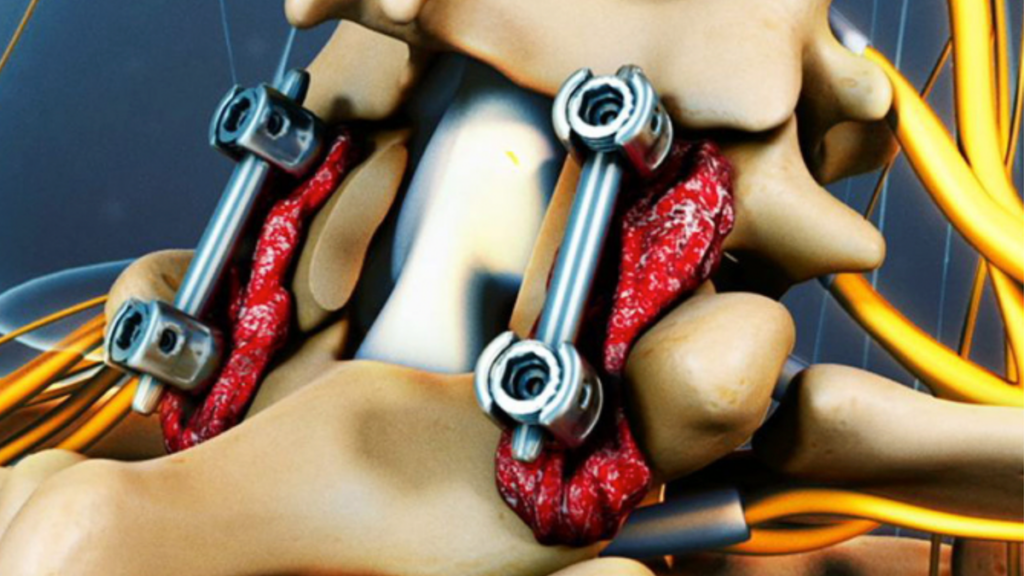Laminectomy with Fusion or Instrumentation
Laminectomy with fusion or instrumentation is a surgery that creates space by removing the lamina — the back part of a vertebra that covers your spinal canal. Also known as decompression surgery, it enlarges your spinal canal to relieve pressure on the spinal cord or nerves. This pressure is most commonly caused by bony and soft tissue overgrowth within the spinal canal, which can occur in people who have arthritis (degenerative disc disease) in their spines.
Bony overgrowths are sometimes referred to as bone spurs, but they’re a normal side effect of the aging process in some people. Laminectomy and laminotomy are generally used only when more conservative treatments — such as medication, physical therapy, or injections — have failed to relieve symptoms. Laminectomy may also be recommended if symptoms are severe or worsening dramatically.
When Is A Laminectomy With Fusion or Instrumentation Considered?
If non-surgical treatment fails to provide significant pain relief and surgery is required, you may need surgical treatment when back or neck pain interferes with daily activities. This procedure is an in-depth surgical technique to remove part or all of one or more vertebral bones (lamina). A herniated disc, injury, narrowing of the spinal canal (spinal stenosis), or tumors that put pressure on the spinal cord and nerves may be relieved by a Decompressive Laminectomy or laminotomy as well. A laminectomy is only considered after other conservative treatments have not worked.
During a conventional laminectomy or laminotomy, the surgeon makes an incision along your spine and then makes an opening in the bony tissue to remove the overgrown or damaged portion compressing the nerves. A spinal fusion may be added if there is instability or scoliosis to increase the success rate. The surgical management of the procedure can take several hours, depending on how many bones are removed.
Who Needs This Kind Of Comprehensive Surgery?
A laminectomy with fusion or instrumentation is often done for back or neck pain after other medical treatments have failed to produce relief. Another reason is when the pain is related to nerve damage. Weakness or numbness in the arms or down the legs can result from pressure on the sciatic nerve. Pressure on the disks in the neck or back (cervical and lumbar spine) can even result in the loss of bladder or bowel control.
Pain in the neck and back can range from mild but persistent to extreme and disabling. Pain can restrict movement and inhibit your ability to function, draining energy and even changing your outlook on life. A laminectomy is an option to relieve the pressure on spinal nerves.
Some of the considerations Dr. Cyr will consider when he evaluates who needs this surgery:
- It is determined that the cause of your initial symptoms is related to spinal cord compression or damage to the nerves in your spinal column.
- Non-surgical therapy such as physical therapy, medication, injections, or chiropractic care hasn’t helped.
- Your overall health supports a compressive surgical procedure
- You have the support you need during the recovery period
- You’re willing to consider this treatment option if it is his expert recommendation for your situation
Benefits include improved quality of life for some people with chronic back or neck pain. As with any surgery of this importance, the surgeon is as important as the choice of procedures.
What Are the Risks of a Laminectomy?
As with all spine surgeries, some standard risks are infection, blood loss, nerve damage, fluid leak, blood clot, and scarring. Complication rates increase in patients over 50 years of age at surgery, who are smoking, are obese, and have a history of previous surgeries to the spine.
Pre-existing conditions such as diabetes, heart disease, high blood pressure, or cancer also increase the risk of complications.
More uncommon and severe complications:
- Numbness and pain in legs or arms
- Shoulder blade area pain
- Weakness or heaviness in your legs and buttocks
- Problems with controlling or emptying your bladder and bowel
- You are more likely to have worse symptoms when standing or walking
Conventional laminectomy is one of the most common back surgeries. During this surgery, Dr. Cyr and the SASpine team removed the back portion of the affected vertebrae (spinal bones). In addition, ligaments, bone spurs, or arthritic malformations pressing on nerves may be addressed at this time for the best surgical outcomes.
After a Laminectomy With Fusion Or Instrumentation
A laminectomy with fusion or instrumentation is generally performed in an outpatient setting unless accompanied by a fusion which requires a hospital stay, usually of a few days. Routine postoperative care will be provided including temperature, blood pressure monitoring, and anesthesia reaction. Your incision is checked for signs of infection, redness, or swelling.
Other aftercare notes:
- Muscle spasms are not uncommon following Laminectomy or Laminotomy. Pain relief and antispasmodic medication will be made available
- A drain tube may be placed at the incision site and may be removed in 1 to 2 days following the procedure
- Intravenous fluids with antibiotics may be given for a few days while in the hospital
- Initially, you will be taught how to roll over in bed. Next, you are taught the proper method of rolling your body to maintain an appropriate body alignment
- In the first 24 hours, you need to walk, sit, or stand for short periods with help as you may experience lightheadedness. Moving without putting stress or strain on your wound site is critical. For the first 48 hours, it is important to not twist, flex, or hyper-extend your spine.
- Arrangements should be made for someone to drive and assist you in the home aftercare.
It is critical for your successful outcome to not put undue stress on your spine, such as bending, lifting, extending, or twisting. Healing and physical therapy are most important during this time.
Dr. Cyr – A Laminectomy Expert
You have the opportunity to choose from world-class surgeons when considering spine surgery. Dr. Steven J. Cyr trained at the prestigious Mayo Clinic spine fellowship and did a combined fellowship in both neurosurgical and orthopedic expertise. Both the Neurosurgery and Orthopedic departments have consistently been ranked number 1 in the country for over twenty years.
Dr. Cyr specializes in treating cervical, thoracic, and lumbar spine conditions. His unique training provides patients with a level of care provided by only a few surgeons in the US.
Additionally, Dr. Cyr’s unique background enables him to understand the source of muscular and skeletal issues, a critical component to resolving pain. Coupled with fellowship training in Orthopedic and Neurosurgery of the spine, his ability to diagnose the source of pain and identify solutions is a great advantage.
What’s Next?
If it’s time to explore more comprehensive solutions to pain from spine conditions that do not respond to conventional or non-intrusive therapies, please make an appointment with Dr. Cyr for a no-obligation visit to discuss a laminectomy with fusion or instrumentation or other procedures specific to your needs. SASpine Center takes over most types of insurance to prioritize access to pain relief.

